Let me now go back to the topic of our meeting already on the first morning in Antananarivo, the capital of Madagascar, which we had with Mikaia concerning the agreed rental of a car and a driver. Namely, to start with, Madagascar does not have good roads, i.e., it has relatively few paved roads. Another thing is that there is public transportation, but if a private vehicle needs 9 hours to cover a certain distance, public transportation in the shape of mini-buses may, for instance, need 15 or more hours for the same thing. Also, everybody said that it was not safe for one to be out on the road at night and there were also pickpockets (in the streets of main cities, as well as in tourist destinations). All of this meant that the two of us agreed to rent a car and a driver for this journey. Moreover, the car was in the shape of a large, comfortable 4x4, since we often had to cover roads full of potholes, so it was desirable to be in a strong car with good shock absorbers, while we were also to go on dirt roads well into the rainy season.
In order to organise all of this, first I made a travel plan by days and then I sent inquiries to several addresses that I managed to obtain. Practically, this turned out to be a proper tender procedure within which I got answers from four “bidders,” while Sneža and I, like a proper commission, decided whom we would choose. For those curious amongst you: it was certainly not the most expensive offer, but it was not the cheapest one either; we opted for the one that seemed to be the most professional, while having a reasonable price. And although this constituted a novelty for the two of us in terms that we were to travel in an exceptionally high style (for us), this is still the most frequent manner of travelling when foreign independent travellers/visitors come to Madagascar.
To start with, the owner of the agency with which we agreed the rental came to our bed and breakfast as previously agreed, along with the vehicle and the driver, since we were to start with our sightseeing right away. Admittedly, originally I thought we would first go to the Royal Hill of Ambohimanga and then to Lemur Park, but Mikaia suggested that we should leave the Royal Hill for the end, since my planned two sites were located at the opposite ends in relation to Antananarivo. Namely, the traffic in the capital of Madagascar is very heavy, with major jams and one wastes a lot of time in these traffic jams. So, we decided to listen to his advice.
Already when leaving the yard of our bed and breakfast by car we began to get acquainted with the circumstances in Madagascar. To start with, Madagascar is a very poor country and thus the surroundings of a very beautiful and well attended B&B with a wonderful garden, as well as a high built fence and a large and strong metal gate which opened only to let the already announced cars to pass, constituted a complete opposite to that small piece of local heaven. Namely, although the houses in the surroundings were also made of bricks, the streets and some small shops in it seemed quite crumbly and thus, being novices in Madagascar, still under the impression of the threatening warnings we had heard before the trip and with insufficient sleep, we were very glad that we rented the vehicle and that we did not need to go on foot there. Already the night before, when we got here from the airport, it was with certain trepidation that we watched these surroundings from the taxi, but even now in broad daylight nothing seemed particularly attractive or reassuring. At least to us and at least at that point in time.
But, as we first headed towards the centre of the city, where Mikaia left us with an agreement to meet up again later on, and farther towards the Lemur Park, we started to relax a little by little.
Since Antananarivo is situated at around 1,280 m a.s.l., irrespective of the hot belt and the tropics, the air temperatures are rather pleasant, at night even so much that it is not necessary to have a fan or air-conditioning in the room. In addition, as it was the rainy season, this also meant that a lot of fields were of intensive green colour. Even in the direct proximity to the centre of the city, as well as when we started to move away from the downtown area, most often we kept seeing rice fields and, by the way, rice is by far the most popular food in Madagascar. Rija, our driver, told us that he thought the Malagasy consumed more rice than the Chinese and thus, regardless of the large domestic production, they still had to import additional quantities.
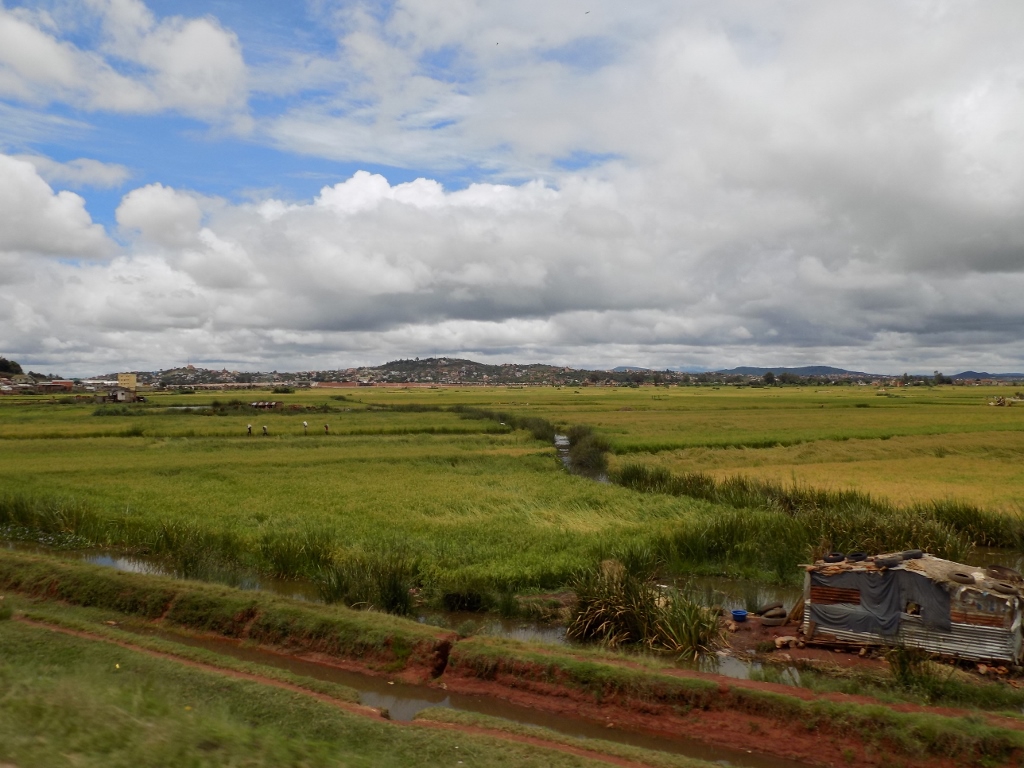 Direct surroundings of Antananarivo
Direct surroundings of Antananarivo
Along our way, we started to get acquainted with some of the “customs” such as the drying of laundry by spreading it over lawns and bushes, and we also saw where the laundry was being washed in one place. Still, the prejudice and the view at the muddy water in which the laundry was being washed should not lead anybody to a wrong conclusion – when you put aside cases of extreme poverty and the wardrobe and hygiene that go along with it, during our entire stay we did not directly encounter anybody who smelt badly or who seemed dirty.
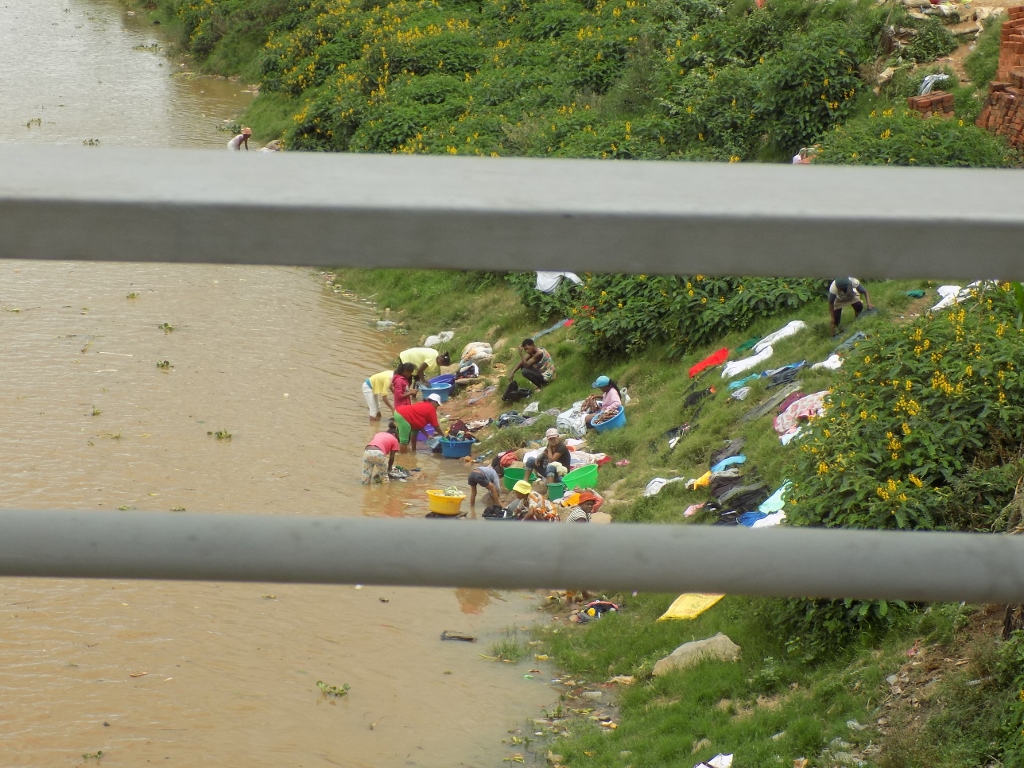 Laundry washing in the surroundings of Antananarivo
Laundry washing in the surroundings of Antananarivo
After a pleasant drive, we came to the Lemur Park which is located some 20 km southwest of the capital and this is a private reserve founded some 20 years ago. On the one side of the park there is the road, while on the other side there is the Katsaoka river. Since it had rained heavily the night before, the river was not only pregnant with water, but it also carried large quantities of earth that gave it a reddish colour.

When we got to the park we were greeted by an employee with a broad smile who was selling tickets and then he handed us over into the hands of a local guide who took us for a stroll around the park. Already the first encounters that day with the agent, the driver, the man selling the tickets in the park and the guide showed us quite clearly that everybody here was exceptionally friendly and kind, and that visitors could feel very well and welcome.
The main reason for the existence of this park-reserve is to place there the lemurs that have been saved from the misfortunate role of being a pet or who have been found injured, sick or endangered while in nature. This is not a zoo in terms that the lemurs are not in cages, they can jump from one tree to another, but they are also sufficiently domesticated and accustomed to the food they are getting, so in exchange for a “roof over their head” and the full board they are quite willing to “strike a pose” for the visitors. While we were walking around the park in the company of the guide, he also drew our attention to the numerous plants that had been planted there, since the park also serves as a smaller botanical garden with over 70 different species of vegetation, including also many endemic species.
Among the first lemurs we came across there was a smaller group of crowned sifakas (Propithecus coronatus) and sifakas are a type of lemurs. This group was located in the tops of the trees under which we were standing, so we could not see them quite well, but soon we got to several specimens of the black-and-white ruffed lemur (Varecia variegata) who were “cooperating” quite nicely.
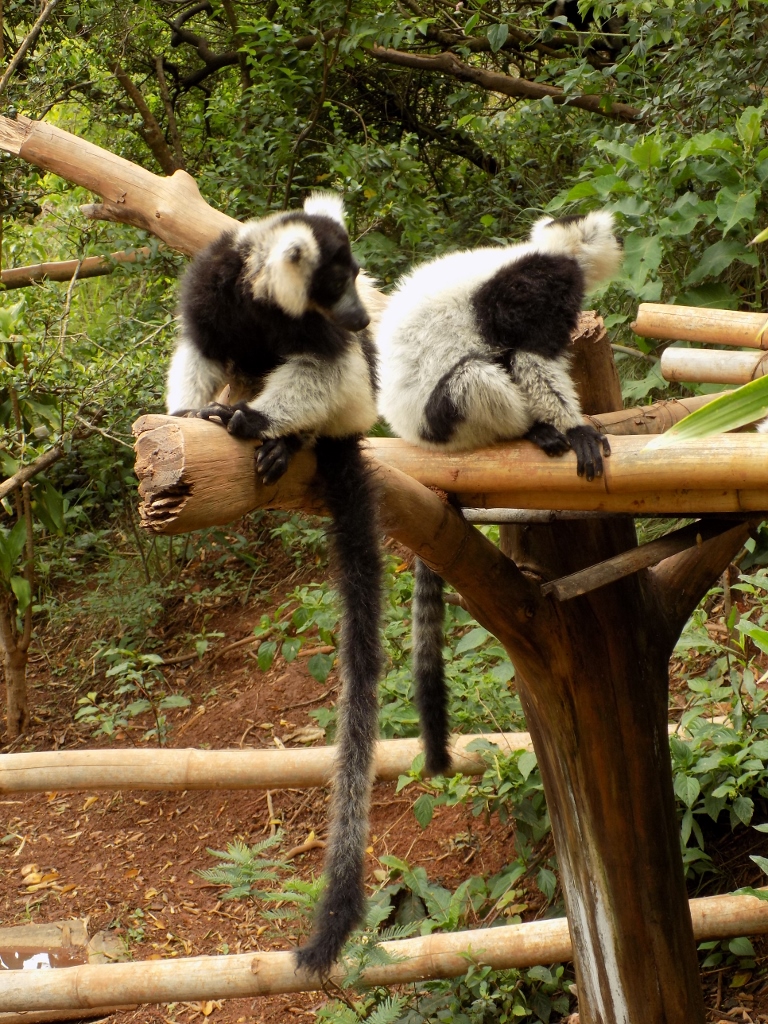 A couple of black-and-white ruffed lemurs
A couple of black-and-white ruffed lemurs
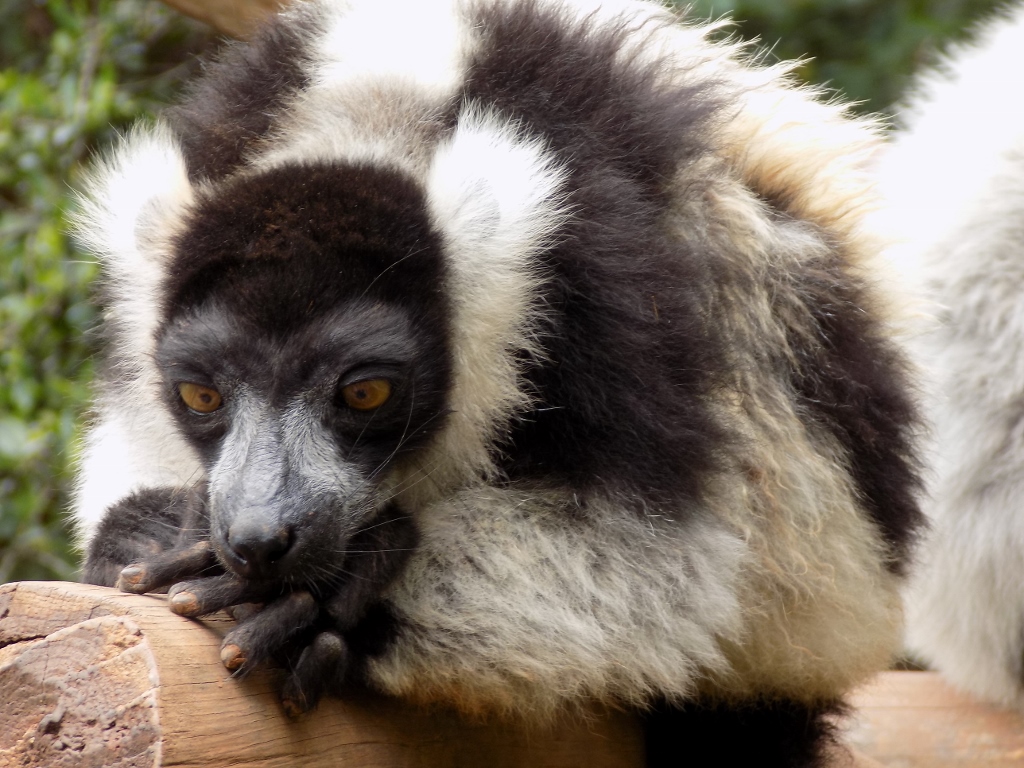 A lost-in-thought lemur
A lost-in-thought lemur
By the way, as I understand it, the sifakas are a type of lemurs who are prone to standing somehow more upright while in trees, they jump more and can cover with a single jump a distance of as much as 10 metres. Also, when they are on the ground, they walk there while being reared and moving sideways, so they are often called “the dancing lemurs.” Be as it may, again we soon came across the crowned sifakas that moved quite swiftly from one tree to another, but I still managed to catch one with my photo-camera.
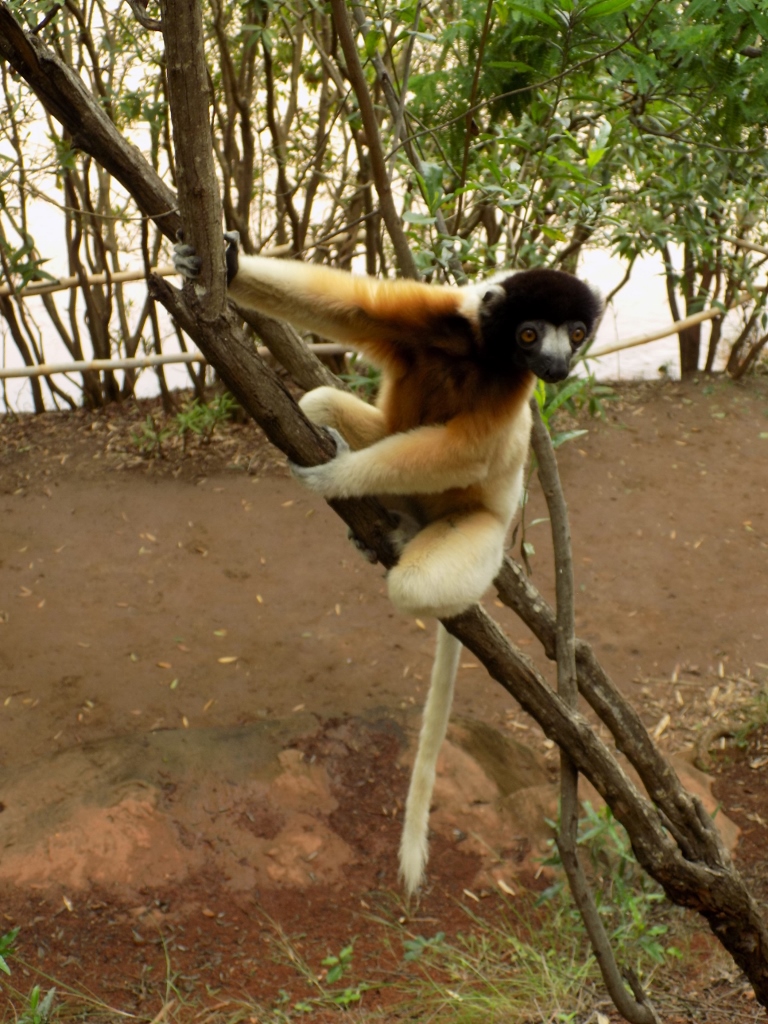 Crowned sifaka
Crowned sifaka
Not too far from there, we came to some large bamboos and there were several Coquerel’s sifakas (Propithecus coquereli) standing there.
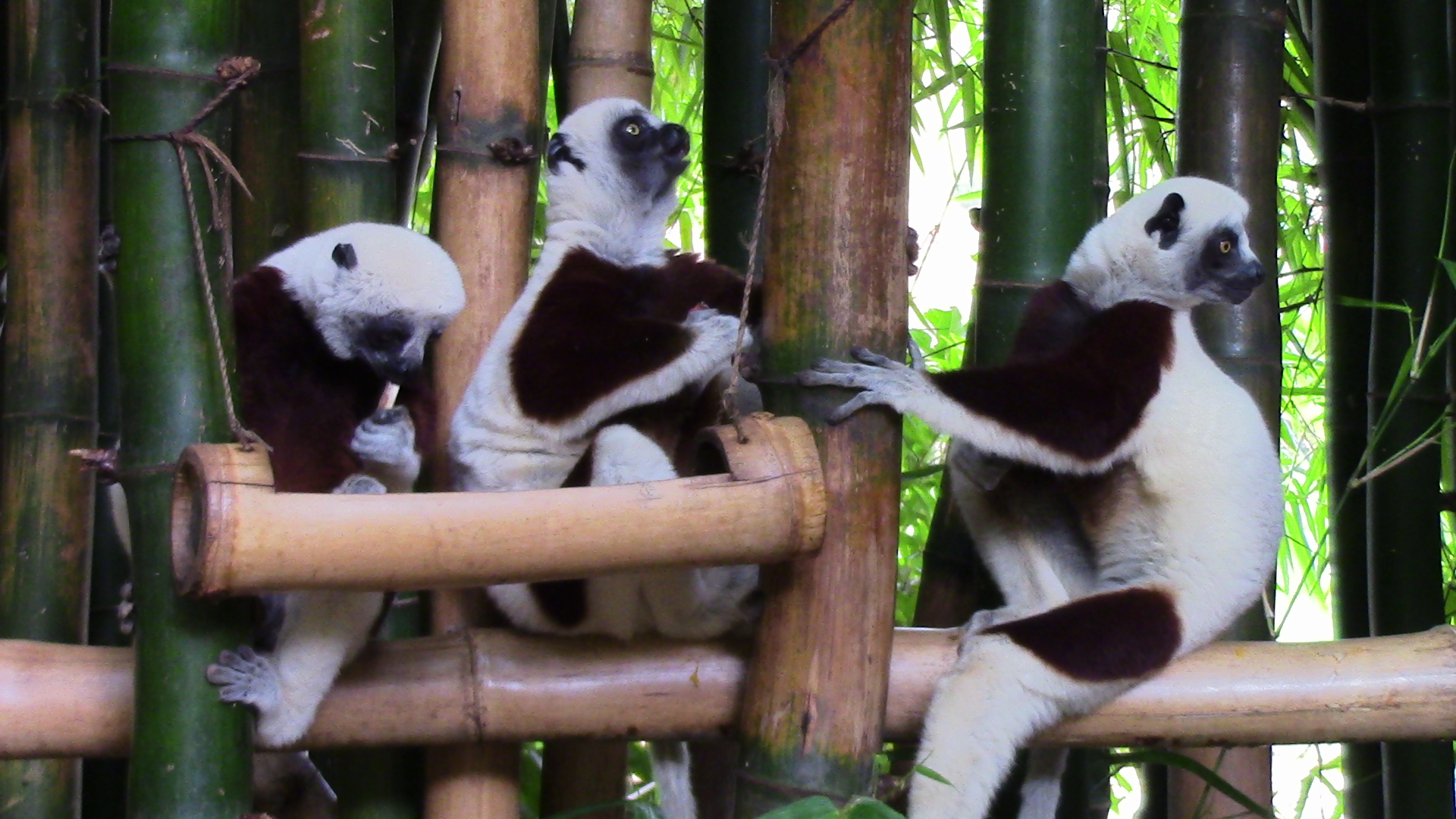
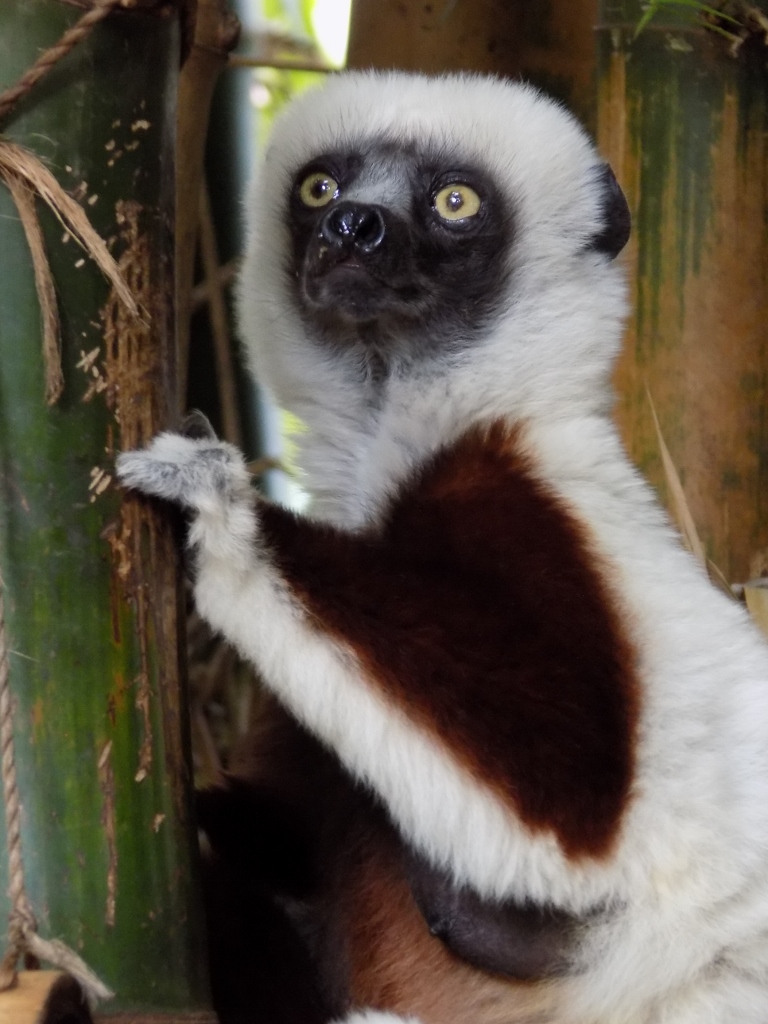 Coquerel’s sifaka
Coquerel’s sifaka
Now, let me explain where all this interest in lemurs comes from. Lemurs are primates, together with monkeys, apes and the man, which is to say they are our close biological relatives. What makes them specific is the very place in which they live, i.e., Madagascar itself, since this is the only place in the world in which lemurs live naturally. Taking into consideration the creation and the history of Madagascar, lemurs have had enough time and freedom to develop into a completely separate group of primates with its variations.
Namely, once upon a time, there was a supercontinent called Gondwana which incorporated a huge land mass. Then the things and in particular pieces of the land started to expand and develop, and thus 165 million years ago Africa separated from the piece of land that included present-day Madagascar, as well as present-day India. Then around some 88 million years ago, India decided to go its separate way as well, so it left Madagascar behind, moved to the northeast and rippled up those Himalayas. This enabled Madagascar and its residents to do their own thing and thus with time it came to a situation in which 70% of the animals and as much as 90% of the plants in Madagascar are – endemic, i.e., they naturally grow and live ONLY in Madagascar and for all of these reasons Madagascar is often called “the eighth continent.” The Homo sapiens appeared here rather late, judging by all merely some 2000 years ago and although it brought its specific chaos over time (the arrival of the man led to the extinction of, among others, a lemur that was the size of a gorilla, as well as one of the biggest birds in the world ever – the elephant bird), the problems seem never ending. On account of the human activities, primarily in the form of deforestation for the purpose of getting arable fields, many animal and plant species are very or extremely endangered.
But, let me go back to our visit to the Lemur Park. In addition to lemurs, it is possible to see some other animals here as well, including radiated tortoises (Astrochelys radiata) which we saw in a section fenced off by rocks. The problem with different species of tortoises in Madagascar is that they have become extremely endangered, some of them being on the verge of extinction, since their specific shells can reach some very high prices. There, wherever you turn, there is some great sadness and the appalling behaviour of the human kind. One simply cannot help but be embarrassed for belonging to such a horrendous group.
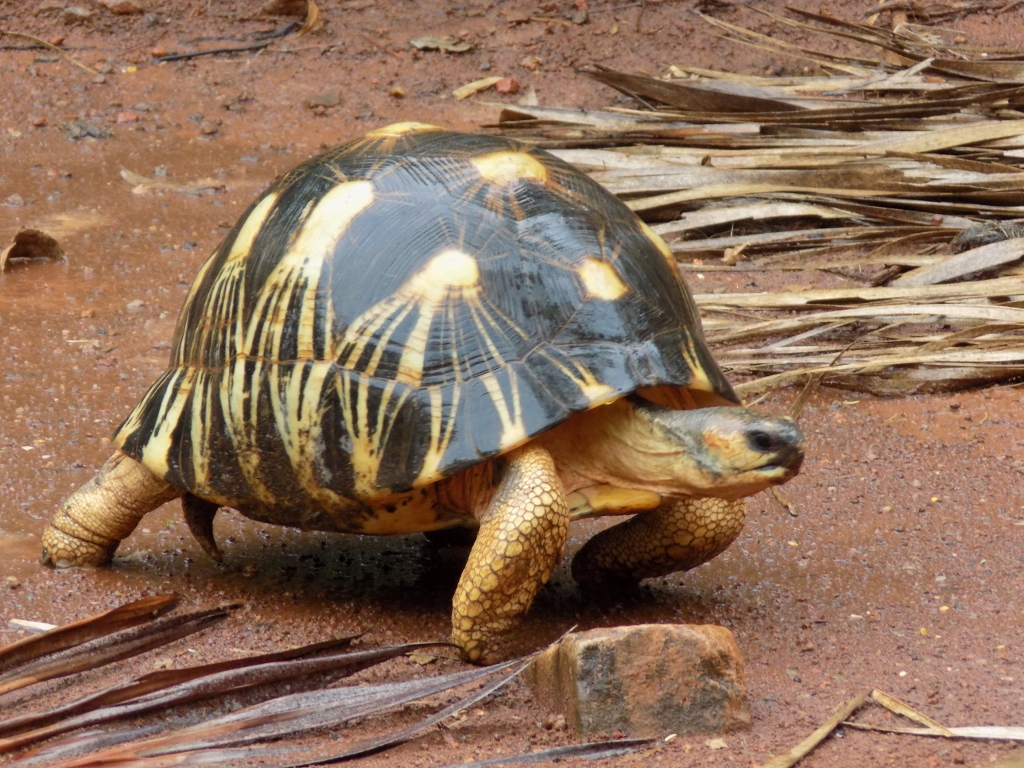 A very determined radiated tortoise
A very determined radiated tortoise
It was around here that it started to rain and since we did not know if this was going to turn into a proper deluge, the guide took us speedily to see another kind of lemurs. These were ring-tailed lemurs (Lemur catta) and as it may be seen in the photo below, expecting the rain they had already closed their ranks.
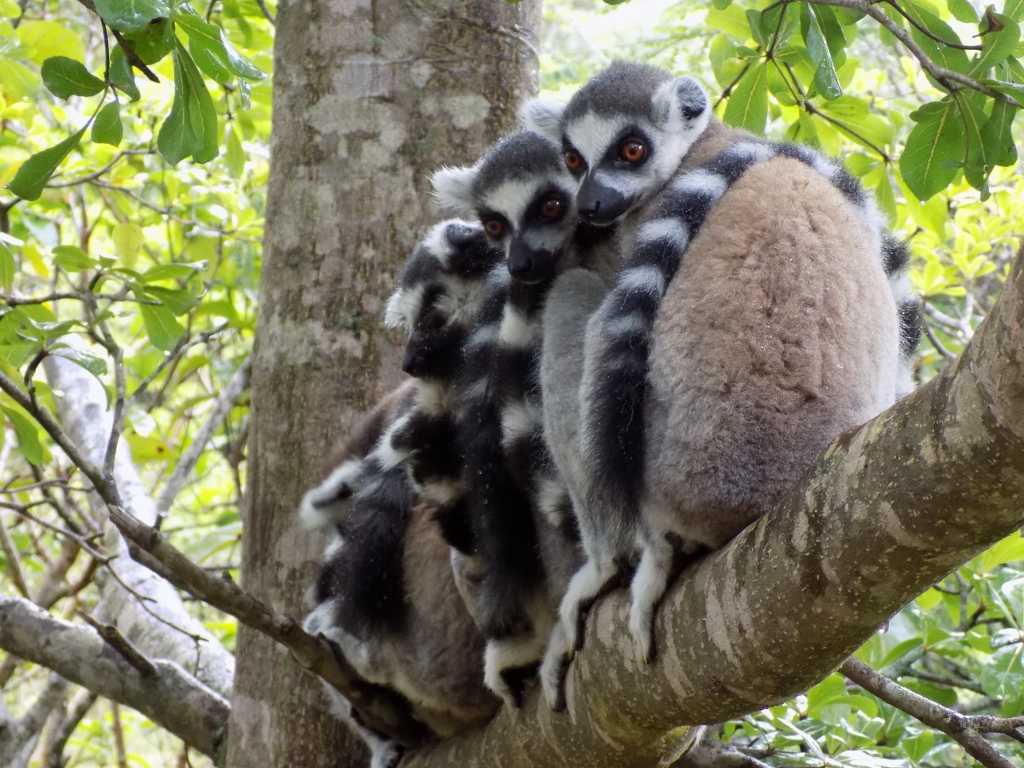 Ring-tailed lemurs
Ring-tailed lemurs
These particularly picturesque lemurs have received a marketing boost in the recent years by landing one of the main roles in the animated film Madagascar.
Since we had some free time after the visit to the Lemur Park, we spontaneously organised it through an agreement with Rija and thus we headed back to Antananarivo. As I’ve said, it started to rain while we were still in the park, but we had actually already expected that. Namely, January was a good month for the two of us to make this trip, but as it turned out January is the peak of the rainy season in Madagascar and everybody I had been in touch with regarding the possible agreement about the car rental first asked me if we had to go there in January. For this reason, I was afraid it could rain the whole day, day in, day out, because who was I to know what the rainy season in Madagascar looked like. For this reason I was actually quite happy that it was not wet during the morning and at the very beginning of our walking tour around the Lemur Park. And yet, as we were returning to Antananarivo, it started to rain almost incessantly, but with different intensity and the water from the rain remained on the surface differently in different places.
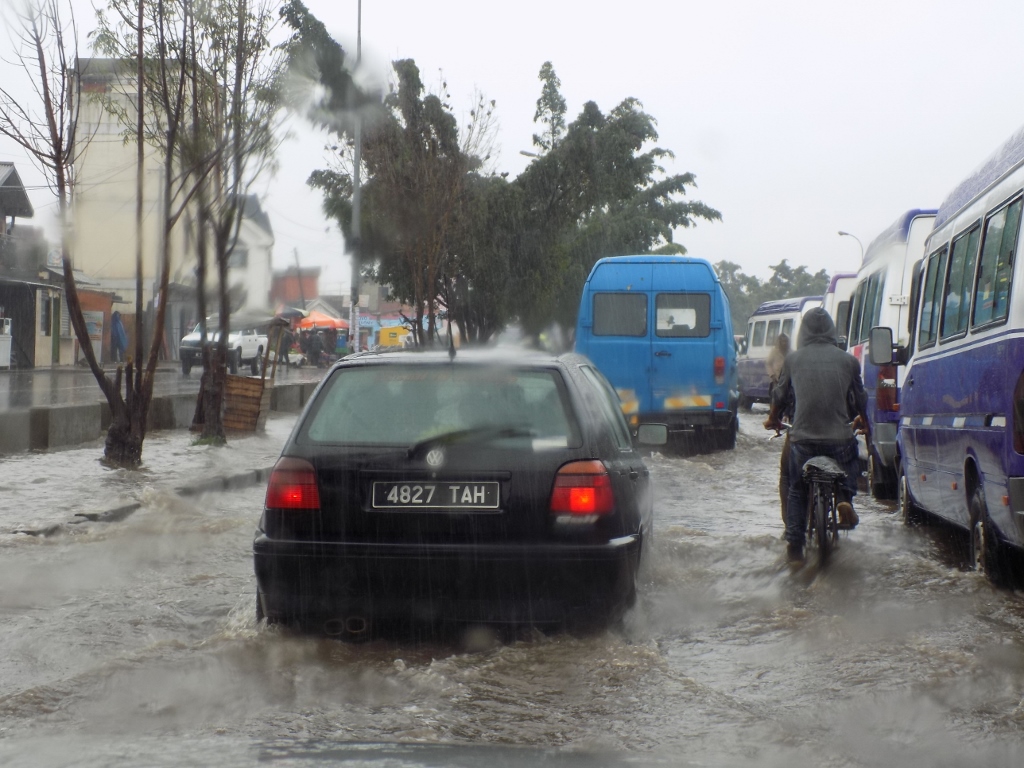 Rain in Antananarivo
Rain in Antananarivo
Be as it may, we decided to go to the Queen’s Palace called Rova which is situated on the top of one hill in the centre of Antananarivo. Rija told us again what we had already found out from the guidebook and this was that the palace had gotten destroyed in a fire several years before, but he also added that the restoration was still going on and that the place was closed for visits. When we got there, it still rained and we could see the outlines of the palace, so we approached the metal fence in order to take photos of whatever could be seen from there. There were also some local guys within the compound and they said the palace could actually be visited. They also said much more and the two of us were delighting thinking that in the meantime it had been opened, while Rija was not aware of it. So, we just briefly told him that we would be back soon, but we actually returned to the car much more quickly than planned, i.e., already in a couple of minutes since one of the “guides” smelled of alcohol and the “entrance tickets” were not sold at the counter which was duly closed, but rather the guys just thought we would give them the money they asked for. I don’t know who these guys were and how they entered the space that was supposed to be closed, but anyway we just went back to the car and continued to the lower parts of the city where we met Mikaia again and went for a late lunch together.
Then, with the two of them we went to a couple of other places we thought could be interesting. One was a shop specialised in spices and I certainly planned to buy vanilla pods since those from Madagascar are considered to be the best ones in the world. However, as it turned out, the vanilla sold in this shop was more expensive than the vanilla from Madagascar I could buy back in Belgrade. So, I bought some very hot small peppers (pili pili peppers) which are less popular in terms of marketing and thus their price was more reasonable.
We also went to an “artistic village” where they make truly impressive models of ancient ships, but neither of us is actually into these things, plus they were absolutely out of our price range. I’m not saying they are not worth the price, making them involves incredibly detailed and dedicated manual work, but this was still not for us.
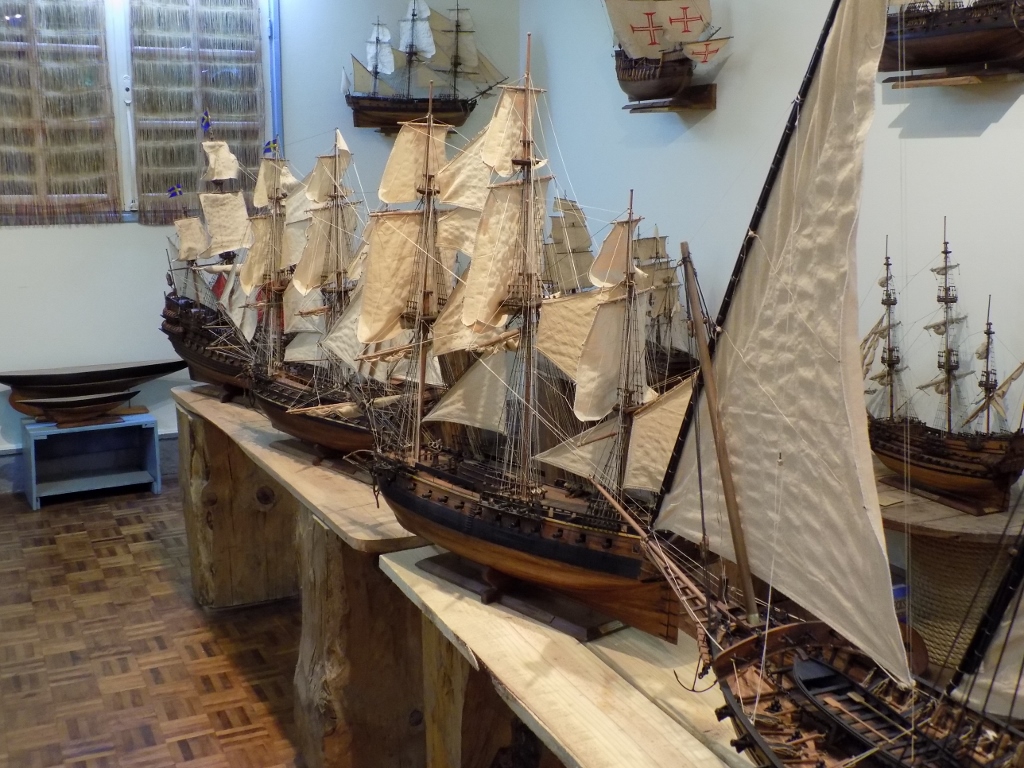 Hand-made models of ancient ships
Hand-made models of ancient ships
On the other hand, it was already late in the afternoon and we were eager to go back to our bed and breakfast and to our room, since we had to have as much rest as possible. Namely, already the next morning we had to get up at 4 am, since we had a 6 o’clock flight to the island of Nosy Be.